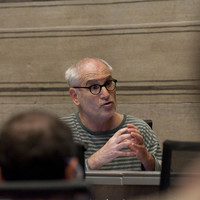Ben Baruch Blich
Bezalel Academy of Arts and Design, History and Theory, Faculty Member
- Comics, Industrial Deign, Animation, Visual Culture, Art, Architecture, and 14 moreDesign History and Theory, Johan Swinnen, דנה אריאלי, Bilu Blich, Aim Luski, Naaman Hirshfeld, Ory Bartal, Bezalel Academy of Art, Miduel Benado, Ben Baruch Blich, Radu Stern, Gal Ventura, Education, and Psychologyedit
Visual images convey information of all sorts. The book examines several trends in visual communication.
The pupose of the paper is to shed light on photographs taken by the Nazis in the concentration camps and ghettos during ww2, and pose the quetion why the photopgraphs were taken for.
Research Interests:
Research Interests:
Research Interests:
Research Interests:
Research Interests:
Research Interests:
Research Interests:
Research Interests:
The claim that architecture is designed for people is not extravagant, as they both occupy architectural spaces and serve as the scale for their design. That is, the human being and body "consume" and, at the same time, delineate... more
The claim that architecture is designed for people is not extravagant, as they both occupy architectural spaces and serve as the scale for their design. That is, the human being and body "consume" and, at the same time, delineate architecture. Vitruvius (1st century BC) is rightly believed to be the first theoretician who saw in the human body not only the means but also the aim of architecture. In architectural practice this body has since been perceived as a paragon of excellence and presented mostly as an analogy of perfection and beauty, of a good gestalt and coherent form.
However, in this article I will raise questions about the maimed body in pain, its twisted and not-beautiful shapes. Has the contemporary idea of architecture addressed this body as well? I will introduce the problem, examine its origins and bring examples where the body is analogous to what is abject, distressed and in pain--all this in an attempt to argue that abjectness is inseparable from our lives.
However, in this article I will raise questions about the maimed body in pain, its twisted and not-beautiful shapes. Has the contemporary idea of architecture addressed this body as well? I will introduce the problem, examine its origins and bring examples where the body is analogous to what is abject, distressed and in pain--all this in an attempt to argue that abjectness is inseparable from our lives.
